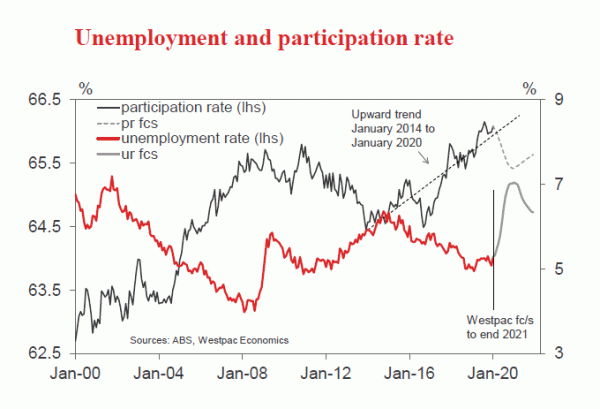On Monday, March 9, we forecast that the Australian economy would experience a recession in 2020 with the economy contracting by 0.6% in the first half although we expected growth in the second half of 2.2% as the economy recovered from the disruption associated with COVID-19.
Our central assumption was that the COVID-19 threat would peak in the June quarter and by quarter’s end confidence and activity would begin to recover.
We described 2020 as a severe disruption or technical recession to differentiate from the last two recessions in Australia when the unemployment rate spiralled from 6% to 11%.
Our figuring last week set the forecast peak in the unemployment rate at around 5.8%- 6%, up from the current level of 5.3%. The relatively modest increase in the unemployment rate was particularly reflective of the expectation that the disruption would be relatively short when compared to earlier recessions and viewed as such by business that there would be a degree of labour hoarding.
Later in the week we analysed the Government’s $17.6 billion Stimulus Package and concluded that the Package would not be sufficiently stimulative to avert a recession in 2020.
Our key assumptions around the Package focussed on the likely impact on spending from the $4.76 billion payments to pensioners and social security recipients and the instant asset write off provisions.
We assessed that pensioners would save around 75% of payments and social security recipients would save around 60%.
Pensioners are likely to be cautious given the collapse in bank deposit rates and health concerns. In that regard the 13.8% collapse in confidence amongst the over 65 year olds in the latest Westpac MI Consumer Sentiment Survey signals caution. Social security recipients will be unnerved by the COVID -19 threats and discouraged by the “one off” nature of the income boost.
We differed with the Government’s figuring around the lift in business investment associated with the “instant asset write off” package assuming around $2 billion compared to the Government’s estimate of $5-6 billion. With business confidence fragile going into the COVID-19 shock and weakening further we expect businesses will be cautious around boosting spending.
Nevertheless, we noted that the Package was likely to boost activity in the June quarter by 0.4% of GDP largely offsetting the estimated contraction. However we noted that conditions had deteriorated over the week and the “pre-package” contraction was now likely to be larger than estimated early last week.
In that regard our revised estimates of GDP growth in the March and June quarters, after adjusting for the Stimulus Package, are minus 0.7% and minus 0.3% respectively – a total contraction of 1% of GDP. Recall that our estimate early last week was a total contraction of 0.6%, before adjusting for the Stimulus Package.
So what has changed?
Most notably we have seen mandatory quarantine requirements for international travellers; restrictions on large public gatherings; a brutal sell off in the global equity markets; and reports of limited liquidity in government and corporate debt markets.
Not surprisingly, as these events have moved quickly, we have made some major changes to our estimates of the impact of COVID-19 in both the March quarter and the June quarter.
We have increased our estimate of the shock to the most exposed component of consumer spending (hotels; restaurants and cafes; recreational services; and air travel) to minus 40% over the two quarters from minus 25%.
We have increased the expected shock to consumer durables to minus 7% and revised up the negative impact on home renovations and additions.
We expect outbound and inbound tourism to contract by 80% over the two quarters.
Overall we now see consumer spending contracting by 0.1% (March quarter) and 2.8% (June quarter) before recovering by 1.9% in the September quarter and 1.0% in the December quarter. We have also made adjustments to inventories; government spending (lifting health expenditure further).
Growth through 2020 is now estimated at 1.5% with minus 1% in the first half and 2.5% in the second half.
The unemployment rate is now forecast to reach 7% by October 2020 (up from the previous estimate of 5.8%-6.0%) due to the larger negative shocks to the labour intensive sectors such as recreation; tourism; education; renovations and additions; and dwelling construction. This lift in the unemployment rate is despite reducing the participation rate from 66.1% to 65.4% as a discouraged worker effect – that is, as workers respond to a deteriorating labour market the participation rate is likely to decline.
Please note that these forecasts are not based on Australia following a European style full lock down. Not surprisingly, the forecasts are subject to downward revision in the event of such an occurrence.












